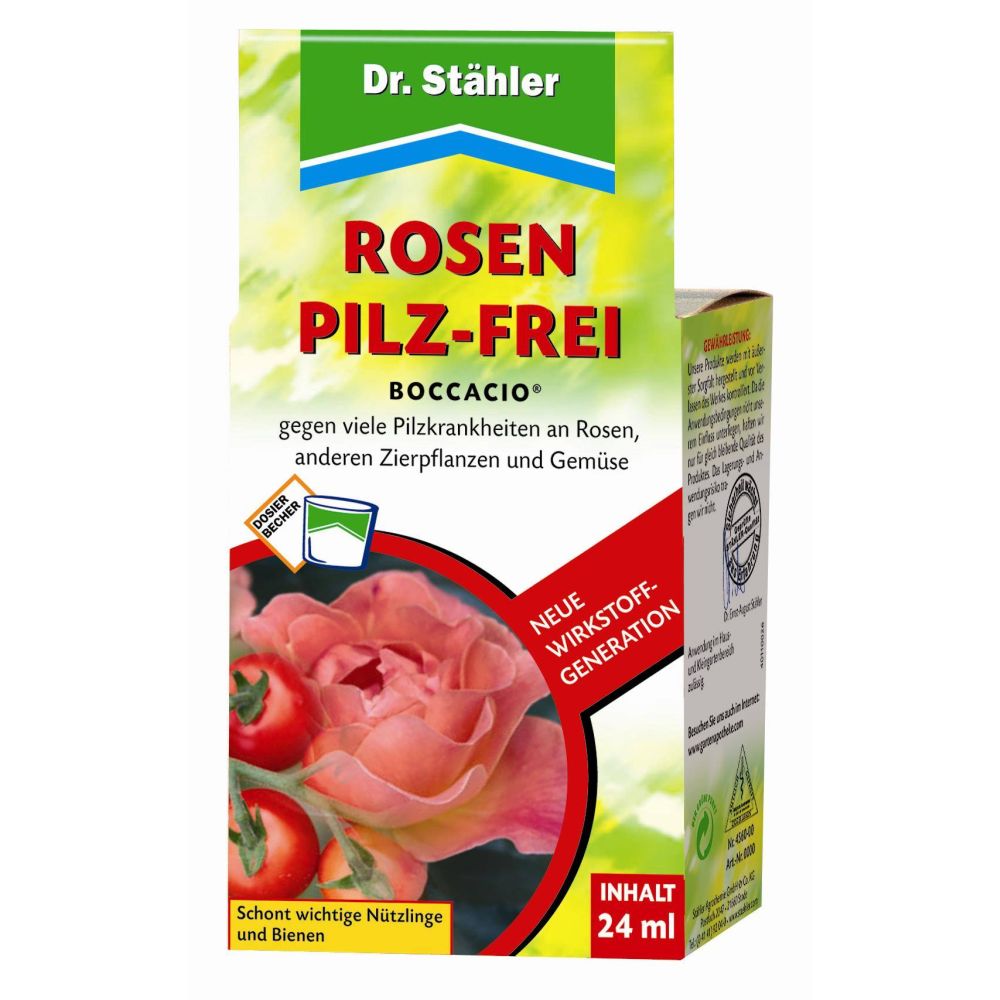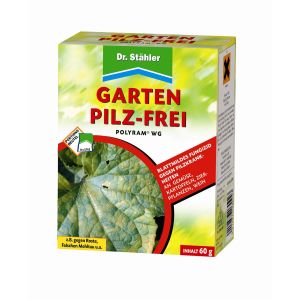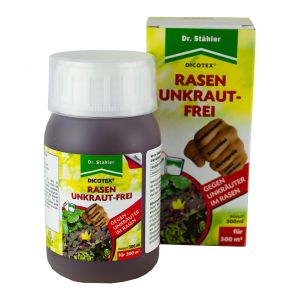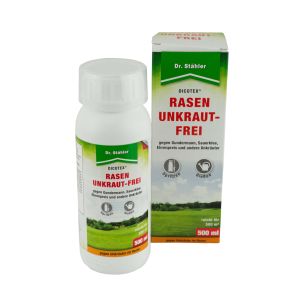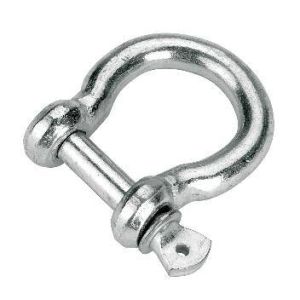Dr. Stähler Rose Fungus Free Boccacio
is reliably effective against many fungal diseases on roses and other ornamental plants as well as on tomatoes, potatoes, cabbages, lettuces, cucumbers and courgettes. The active ingredient, developed on the basis of nature, penetrates the plant tissue and spreads there with the sap flow.
Rose Fungus-Free Boccacio not only combats fungal diseases, but the treated plants become altogether stronger, greener and more productive. The long-lasting effect allows long spraying intervals of 8 - 28 days, depending on the infection pressure and new growth.
Fungicidal suspension concentrate
Content: 24 ml with dosing cup
Active ingredient: 250 g/l azoxystrobin
End of approval: 31.12.2022
Registration number: 024560-73(permitted in home and allotment gardens)
Application
Vegetable crops
Cauliflower, broccoli, leafy cabbage (field)
Against cabbage blackness, white rust, ring spot disease (Mycosphaerella brassicicola): spray 10 ml per 100 m² in 2 - 6 l/100 m² water,
Time of application: at the beginning of infestation or when the first symptoms become visible. Max. 2 applications in the crop or per year at intervals of 8 - 12 days.
Recommended concentration: 4 ml in 2.4 l water for 40 m².
The maximum number of applications is limited for reasons specific to the active ingredient. Sufficient control cannot be expected in all cases. If necessary, therefore, use agents with other active ingredients subsequently or alternately (WW750). To prevent the development of resistance, use the product in alternation with other products from other active ingredient groups (WW764).
Cucumber (outdoor)
Against powdery mildew and downy mildew: spray 10 ml per 100 m² in 3 - 6 l/100 m² water,
Time of application: at the beginning of infestation or when the first symptoms become visible. Max. 2 applications in the crop or per year at intervals of 8 - 12 days.
Recommended concentration: 4 ml in 2.4 l water for 40 m².
The maximum number of applications is limited for reasons specific to the active ingredient. Sufficient control cannot be expected in all cases. If necessary, therefore, use agents with other active ingredients subsequently or alternately (WW750). To prevent the development of resistance, use the product in alternation with other products from other active ingredient groups (WW764).
Cucumber (greenhouse)
Against powdery mildew and downy mildew
Plant size up to 50 cm: 4.8 ml per 100 m²
Plant size 50 to 125 cm: 7.2 ml per 100 m²
Plant size over 125 cm: 9.6 ml per 100 m² spray in 6 - 12 l/100 m² water,
Time of application: at the beginning of infestation or when the first symptoms become visible. Max. 2 applications in the crop or per year at intervals of 8 - 12 days.
Recommended concentration: 4 ml in 5 l water.
The maximum number of applications is limited for reasons specific to the active ingredient. Sufficient control cannot be expected in all cases. If necessary, therefore, use agents with other active ingredients subsequently or alternately (WW750). To prevent the development of resistance, use the product in alternation with other products from other active ingredient groups (WW764).
Potato
Against drought spot disease (Alternaria species): Spray 5 ml per 100 m² in 2 - 6l/100 m² water,
Time of application: at the beginning of infestation or when the first symptoms become visible. Max. 3 applications in the crop or per year at intervals of 14 - 28 days.
Recommended concentration: 4 ml in 2.4 l water for 40 m².
Limited efficacy possible (WW760). For reasons of resistance management, do not use the product (including other products with the same active ingredient, with an active ingredient from the same active ingredient group or with a cross-resistant active ingredient) more frequently overall than specified in the instructions for use. If in doubt, consult an advisory service (WW762).
Head cabbage (red, white, pointed and savoy cabbage) (field)
Against cabbage blackness, white rust, ring spot disease (Mycosphaerella brassicicola): spray 10 ml per 100 m² in 2 - 6 l/100 m² water,
Time of application: at the beginning of infestation or when the first symptoms become visible. Max. 2 applications in the crop or per year at intervals of 8 - 12 days.
Recommended concentration: 4 ml in 2.4 l water for 40 m².
The maximum number of applications is limited for reasons specific to the active ingredient. Sufficient control cannot be expected in all cases. If necessary, therefore, use agents with other active ingredients subsequently or alternately (WW750). To prevent the development of resistance, use the product in alternation with other products from other active ingredient groups (WW764).
Brussels sprouts
Against cabbage blackness, white rust, ring spot disease (Mycosphaerella brassicicola): spray 10 ml per 100 m² in 2 - 6 l/100 m2 water,
Time of application: at the beginning of infestation or when the first symptoms become visible. Max. 2 applications in the crop or per year at intervals of 8 - 12 days.
Recommended concentration: 4 ml in 2.4 l water for 40 m².
The maximum number of applications is limited for reasons specific to the active ingredient. Sufficient control cannot be expected in all cases. If necessary, therefore, use agents with other active ingredients subsequently or alternately (WW750). To prevent the development of resistance, use the product in alternation with other products from other active ingredient groups (WW764).
Lettuce, endive (outdoor)
Against downy mildew, black rot (Rhizoctonia solani): spray 10 ml per 100 m² in 2 - 6 l/100 m² water,
Time of application: at the beginning of infestation or when the first symptoms become visible. Max. 2 applications in the crop or per year at intervals of 8 - 12 days.
Recommended concentration: 4 ml in 2.4 l water for 40 m².
The maximum number of applications is limited for reasons specific to the active ingredient. Sufficient control cannot be expected in all cases. If necessary, therefore, use agents with other active ingredients subsequently or alternately (WW750). To prevent the development of resistance, use the product in alternation with other products from other active ingredient groups (WW764).
Tomato (greenhouse)
Against powdery mildew, late blight, velvet blotch (in our own experience, drought blotch is also covered by the approved application).
Plant size up to 50 cm: 4.8 ml per 100 m²
plant size 50 to 125 cm: 7,2 ml per 100 m²
Plant size over 125 cm: 9.6 ml per 100 m² spray in 6 - 12 l/100 m² water,
Time of application: at the beginning of infestation or when the first symptoms become visible. Max. 2 applications in the crop or per year at intervals of 8 - 12 days.
Recommended concentration: 4 ml in 5 l water.
The maximum number of applications is limited for reasons specific to the active ingredient. Sufficient control cannot be expected in all cases. If necessary, therefore, use agents with other active ingredients subsequently or alternately (WW750). To prevent the development of resistance, use the product in alternation with other products from other active ingredient groups (WW764).
Courgettes (outdoor)
Against powdery mildew: spray 10 ml per 100 m² in 2 - 6 l/100 m² water,
Time of application: at the beginning of infestation or when the first symptoms become visible. Max. 2 applications in the crop or per year at intervals of 8 - 12 days.
Recommended concentration: 4 ml in 2.4 l water for 40 m².
The maximum number of applications is limited for reasons specific to the active ingredient. Sufficient control cannot be expected in all cases. If necessary, therefore, use agents with other active ingredients subsequently or alternately (WW750). To prevent the development of resistance, use the product in alternation with other products from other active ingredient groups (WW764).
Ornamentals
Ornamental plants (roses) (greenhouse)
Against rust fungi (powdery mildew, leaf spot or star sooty mould are included in the approved application according to our own experience).
plant size up to 50 cm: 4.8 ml per 100 m²
Plant size 50 to 125 cm: 7.2 ml per 100 m²
Plant size over 125 cm: 9.6 ml per 100 m² spray in 5 l/100 m² water,
Time of application: at the beginning of infestation or when the first symptoms become visible. Max. 2 applications in the crop or per year at intervals of 8 - 12 days.
Recommended concentration: 4 ml in 5 l water.
The maximum number of applications is limited for reasons specific to the active ingredient. Sufficient control cannot be expected in all cases. If necessary, therefore, use agents with other active ingredients subsequently or alternately (WW750). To prevent the development of resistance, use the product in alternation with other products from other active ingredient groups (WW764).
Plant compatibility
When treating cucumbers in the greenhouse and courgettes in the open, damage cannot be excluded depending on the crop, variety and cultivation method. Therefore, do not apply in the greenhouse in the evening. There are no findings on incompatibilities with individual plant species and varieties. For tomatoes under glass do not use at temperatures above 27° C and not in protected cultivation with low ventilation (e.g. under foil). Irrespective of the plant species, trial sprays should therefore be carried out before treating larger crops. Do not treat pome fruit (including ornamental species thereof), ornamental cherries, usambara violets (sensitive especially from bud opening), seedlings and stressed plants. Avoid drift on these plants.
Application technique
Preparation of the spray broth
Shake well before use. Add agent to water while stirring. Shake the spray tank after breaks in spraying. Boccacio Rose Fungus-Free is diluted with water. Always prepare only as much spray liquid as is needed. The measuring cup allows an exact dosage! For ornamental plants and tomatoes, the required amount of spray liquid depends on the height of the plants: up to 50 cm: 5 l spray liquid is sufficient for 83 m² 50 to 125 cm: 5 l spray liquid is sufficient for 56 m² over 125 cm: 5 l spray liquid is sufficient for 42 m² Avoiding the formation of resistance: Always apply early, then fungal diseases can be controlled most successfully. Always adhere to the recommended concentration and do not spray too often. We recommend a maximum of 2 applications per year and alternating with other products (e.g. Rosen Pilz-Frei Rosal AF or Garten Pilz-Frei Polyram WG).
Application technique
Always apply the product alone, do not mix with liquid fertilizers or other products. Apply at the earliest 3 weeks after planting and not from November to March. Spray coating should always dry quickly, therefore do not apply under cool, damp conditions, especially with poor ventilation (e.g. under foil or in cold frames).
Cleaning
After use, thoroughly clean sprayers on unsealed floor first with water, then with rinsing agent solution. Spray cleaning water on the previously treated area.
Waiting time
Endives, head cabbage, Brussels sprouts, lettuces: 14 days
Cucumber, tomato, zucchini: 3 days
Potato: 7 days
Cauliflower: 10 days
Broccoli, leaf cabbage: 14 days
Ornamental plants: no relevance (N)
Environmental fate
Bees
The product is classified as non-hazardous to bees (B4) up to the highest application rate specified by the registration or application concentration if an application rate is not provided (NB6641).
Beneficial insects
The product is classified as non-harmful to populations of the species Pardosa amentata and palustris (wolf spiders) (NN130). The product is classified as non-harmful to populations of the species Typhlodromus pyri (predatory mite) (NN134). The product is classified as non-harmful to populations of the species Orius laevigatus (predatory flower bug) (NN1513). The product is classified as non-detrimental to populations of the species Coccinella septempunctata (seven-spot ladybird) (NN161). The product is classified as non-harmful to populations of the species Poecilus cupreus (ground beetle) (NN165). The product is classified as non-detrimental to populations of the species Chrysoperla carnea (lacewing) (NN170). The product is classified as having a low harmful effect on populations of the species Episyrphus balteatus (hoverfly) (NN291). The agent is classified as non-harmful to populations of the species Aphidius rhopalosiphi (braconid wasp) (NN1842).
Fish
The product is toxic to fish and fish food animals (NW264).
Algae
The agent is toxic to algae (NW262).
Waters/groundwater
The application of the product in or directly on surface waters or coastal waters is not permitted (§ 6 Para. 2 PflSchG). Irrespective of this, the mandatory minimum distance to surface waters as stipulated by federal state law must be observed. Violations can be punished with a fine of up to 50,000 euros (NW642).
Storage
Storeseparately from food and feed, out of reach of children and only in the sealed original packaging.
Information for safe handling
To avoid risks to humans and the environment, follow the directions for use (SP001).
User protection
Avoid all unnecessary contact with the product. Misuse may cause damage to health (SB001). The guideline for the requirements for personal protective equipment in crop protection "Personal protective equipment when handling crop protection agents" of the Federal Office of Consumer Protection and Food Safety must be observed (SB110). Do not re-enter treated areas/crops until the spray coating has dried (SF245-01).
Labelling GefStoffV
R 50/53: Very toxic to aquatic organisms, may cause long-term adverse effects in the aquatic environment. S 23: Do not breathe vapour/aerosol. S 35: Waste and containers must be disposed of in a safe way. S 51: Use only in well ventilated areas. S 57: Use suitable container to avoid contamination of the environment. To avoid risks to man and the environment, follow the directions for use. - SP001 Packaging must not be reused.


| Delivery time | 2-3 Tage |
|---|---|
| EAN | 4015574004459 |
| Manufacturer Article no. | 3133 |
| Manufacturer | Dr. Stähler |
| Active ingredients | Azoxystrobin |
| Pestizid | No |
| Application notes |
Gemüsebau Blumenkohl, Brokkoli, Blattkohle (Freiland) Anwendungszeitpunkt: bei Befallsbeginn bzw. bei Sichtbarwerden der ersten Symptome. Max. 2 Anwendungen in der Kultur bzw. je Jahr im Abstand von 8 - 12 Tagen. Die maximale Anzahl der Anwendungen ist aus wirkstoffspezifischen Gründen eingeschränkt. Ausreichende Bekämpfung ist damit nicht in allen Fällen zu erwarten. Gegebenenfalls deshalb anschließend oder im Wechsel Mittel mit anderen Wirkstoffen verwenden (WW750). Um Resistenzbildungen vorzubeugen, das Mittel im Wechsel mit anderen Mitteln aus anderen Wirkstoffgruppen verwenden (WW764). Gurke (Freiland) Anwendungszeitpunkt: bei Befallsbeginn bzw. bei Sichtbarwerden der ersten Symptome. Max. 2 Anwendungen in der Kultur bzw. je Jahr im Abstand von 8 - 12 Tagen. Die maximale Anzahl der Anwendungen ist aus wirkstoffspezifischen Gründen eingeschränkt. Ausreichende Bekämpfung ist damit nicht in allen Fällen zu erwarten. Gegebenenfalls deshalb anschließend oder im Wechsel Mittel mit anderen Wirkstoffen verwenden (WW750). Um Resistenzbildungen vorzubeugen, das Mittel im Wechsel mit anderen Mitteln aus anderen Wirkstoffgruppen verwenden (WW764). Gurke (Gewächshaus) Pflanzengröße bis 50 cm: 4,8 ml je 100 m² Pflanzengröße 50 bis 125 cm: 7,2 ml je 100 m² Pflanzengröße über 125 cm: 9,6 ml je 100 m² spritzen in 6 - 12 l/100 m² Wasser, Anwendungszeitpunkt: bei Befallsbeginn bzw. bei Sichtbarwerden der ersten Symptome. Max. 2 Anwendungen in der Kultur bzw. je Jahr im Abstand von 8 - 12 Tagen. Die maximale Anzahl der Anwendungen ist aus wirkstoffspezifischen Gründen eingeschränkt. Ausreichende Bekämpfung ist damit nicht in allen Fällen zu erwarten. Gegebenenfalls deshalb anschließend oder im Wechsel Mittel mit anderen Wirkstoffen verwenden (WW750). Um Resistenzbildungen vorzubeugen, das Mittel im Wechsel mit anderen Mitteln aus anderen Wirkstoffgruppen verwenden (WW764). Kartoffel Anwendungszeitpunkt: bei Befallsbeginn bzw. bei Sichtbarwerden der ersten Symptome. Max. 3 Anwendungen in der Kultur bzw. je Jahr im Abstand von 14 - 28 Tagen. Eingeschränkte Wirksamkeit möglich (WW760). Aus Gründen des Resistenzmanagements das Mittel (einschließlich anderer Mittel mit gleichem Wirkstoff, mit einem Wirkstoff aus der gleichen Wirkstoffgruppe oder mit kreuzresistentem Wirkstoff) insgesamt nicht häufiger anwenden als in der Gebrauchsanleitung angegeben. Im Zweifel einen Beratungsdienst hinzuziehen (WW762). Kopfkohle (Rot-, Weiß-, Spitz- und Wirsingkohl) (Freiland) Anwendungszeitpunkt: bei Befallsbeginn bzw. bei Sichtbarwerden der ersten Symptome. Max. 2 Anwendungen in der Kultur bzw. je Jahr im Abstand von 8 - 12 Tagen. Die maximale Anzahl der Anwendungen ist aus wirkstoffspezifischen Gründen eingeschränkt. Ausreichende Bekämpfung ist damit nicht in allen Fällen zu erwarten. Gegebenenfalls deshalb anschließend oder im Wechsel Mittel mit anderen Wirkstoffen verwenden (WW750). Um Resistenzbildungen vorzubeugen, das Mittel im Wechsel mit anderen Mitteln aus anderen Wirkstoffgruppen verwenden (WW764). Rosenkohl Anwendungszeitpunkt: bei Befallsbeginn bzw. bei Sichtbarwerden der ersten Symptome. Max. 2 Anwendungen in der Kultur bzw. je Jahr im Abstand von 8 - 12 Tagen. Die maximale Anzahl der Anwendungen ist aus wirkstoffspezifischen Gründen eingeschränkt. Ausreichende Bekämpfung ist damit nicht in allen Fällen zu erwarten. Gegebenenfalls deshalb anschließend oder im Wechsel Mittel mit anderen Wirkstoffen verwenden (WW750). Um Resistenzbildungen vorzubeugen, das Mittel im Wechsel mit anderen Mitteln aus anderen Wirkstoffgruppen verwenden (WW764). Salate, Endivien (Freiland) Anwendungszeitpunkt: bei Befallsbeginn bzw. bei Sichtbarwerden der ersten Symptome. Max. 2 Anwendungen in der Kultur bzw. je Jahr im Abstand von 8 - 12 Tagen. Die maximale Anzahl der Anwendungen ist aus wirkstoffspezifischen Gründen eingeschränkt. Ausreichende Bekämpfung ist damit nicht in allen Fällen zu erwarten. Gegebenenfalls deshalb anschließend oder im Wechsel Mittel mit anderen Wirkstoffen verwenden (WW750). Um Resistenzbildungen vorzubeugen, das Mittel im Wechsel mit anderen Mitteln aus anderen Wirkstoffgruppen verwenden (WW764). Tomate (Gewächshaus) Pflanzengröße bis 50 cm: 4,8 ml je 100 m² Pflanzengröße 50 bis 125 cm: 7,2 ml je 100 m² Pflanzengröße über 125 cm: 9,6 ml je 100 m² spritzen in 6 - 12 l/100 m² Wasser, Anwendungszeitpunkt: bei Befallsbeginn bzw. bei Sichtbarwerden der ersten Symptome. Max. 2 Anwendungen in der Kultur bzw. je Jahr im Abstand von 8 - 12 Tagen. Die maximale Anzahl der Anwendungen ist aus wirkstoffspezifischen Gründen eingeschränkt. Ausreichende Bekämpfung ist damit nicht in allen Fällen zu erwarten. Gegebenenfalls deshalb anschließend oder im Wechsel Mittel mit anderen Wirkstoffen verwenden (WW750). Um Resistenzbildungen vorzubeugen, das Mittel im Wechsel mit anderen Mitteln aus anderen Wirkstoffgruppen verwenden (WW764). Zucchini (Freiland) Anwendungszeitpunkt: bei Befallsbeginn bzw. bei Sichtbarwerden der ersten Symptome. Max. 2 Anwendungen in der Kultur bzw. je Jahr im Abstand von 8 - 12 Tagen. Die maximale Anzahl der Anwendungen ist aus wirkstoffspezifischen Gründen eingeschränkt. Ausreichende Bekämpfung ist damit nicht in allen Fällen zu erwarten. Gegebenenfalls deshalb anschließend oder im Wechsel Mittel mit anderen Wirkstoffen verwenden (WW750). Um Resistenzbildungen vorzubeugen, das Mittel im Wechsel mit anderen Mitteln aus anderen Wirkstoffgruppen verwenden (WW764). Zierpflanzenbau Zierpflanzen (Rosen) (Gewächshaus) Pflanzengröße bis 50 cm: 4,8 ml je 100 m² Pflanzengröße 50 bis 125 cm: 7,2 ml je 100 m² Pflanzengröße über 125 cm: 9,6 ml je 100 m² spritzen in 5 l/100 m² Wasser, Anwendungszeitpunkt: bei Befallsbeginn bzw. bei Sichtbarwerden der ersten Symptome. Max. 2 Anwendungen in der Kultur bzw. je Jahr im Abstand von 8 - 12 Tagen. Die maximale Anzahl der Anwendungen ist aus wirkstoffspezifischen Gründen eingeschränkt. Ausreichende Bekämpfung ist damit nicht in allen Fällen zu erwarten. Gegebenenfalls deshalb anschließend oder im Wechsel Mittel mit anderen Wirkstoffen verwenden (WW750). Um Resistenzbildungen vorzubeugen, das Mittel im Wechsel mit anderen Mitteln aus anderen Wirkstoffgruppen verwenden (WW764). Pflanzenverträglichkeit Bei der Behandlung von Gurken im Gewächshaus und Zucchini im Freiland können Schäden in Abhängigkeit von Kultur, Sorte und Anbauverfahren nicht ausgeschlossen werden. Im Gewächshaus deshalb nicht abends anwenden. Erkenntnisse über Unverträglichkeiten bei einzelnen Pflanzenarten und -sorten liegen nicht vor. Bei Tomaten unter Glas nicht bei Temperaturen über 27° C einsetzen und nicht im geschützten Anbau mit geringer Belüftung (z.B. unter Folie). Unabhängig von der Pflanzenart sind deshalb vor der Behandlung größerer Bestände Probespritzungen durchzuführen. Kernobst (auch Zierarten davon), Zierkirschen, Usambaraveilchen (empfindlich besonders ab Knospenöffnen), Sämlinge und gestresste Pflanzen nicht behandeln. Abtrift auf diese Pflanzen vermeiden. Anwendungstechnik Ansetzen der Spritzbrühe Ausbringungstechnik Reinigung Wartezeit Umweltverhalten Bienen Nützlinge Fische Algen Gewässer/Grundwasser Lagerung Hinweise für sicheren Umgang Zur Vermeidung von Risiken für Mensch und Umwelt ist die Gebrauchsanleitung einzuhalten (SP001). Anwenderschutz |
Manufacturer: Schopf Hygiene Bitterfeld GmbH & Co.KG, Elektronstrasse 8, 06749 Bitterfeld-Wolfen, DE, info@schopf-bitterfeld.de

